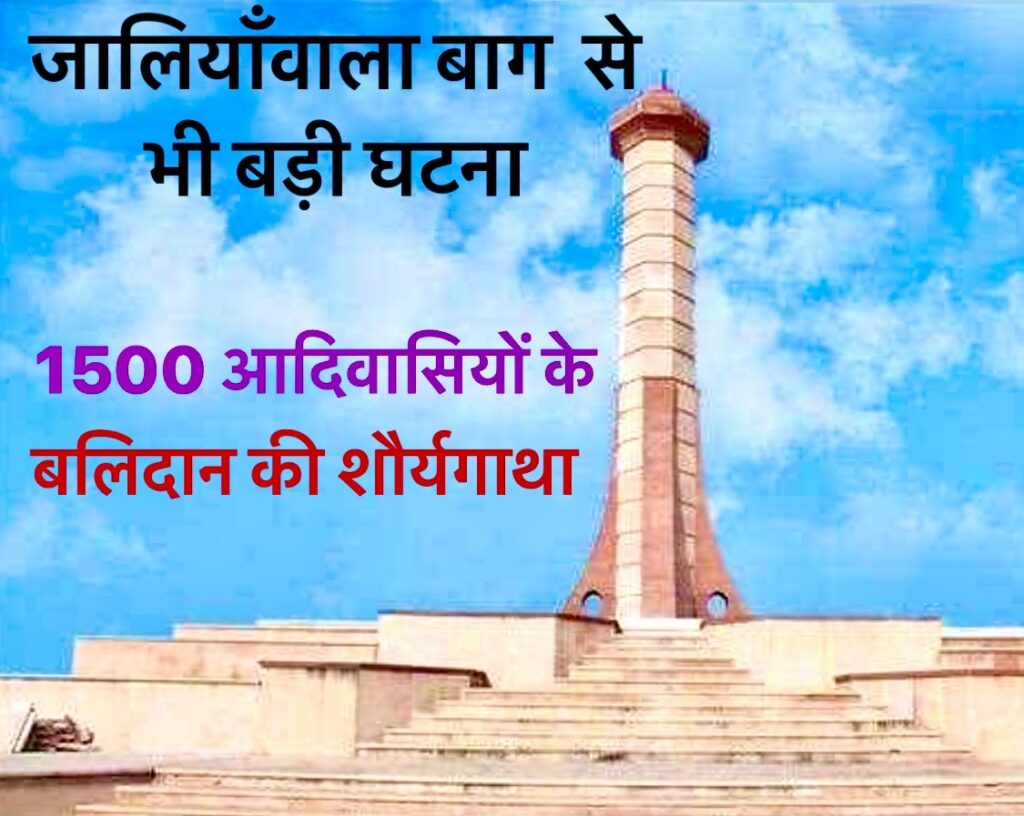
जालियाँवाला बाग कांड से भी बड़ी घटना
1500 आदिवासियों की हत्या
शौर्यगाथा
बलिदान दिवस
अमर बलिदान का साक्षी मानगढ़ धाम
(17 नवम्बर 1913)
मानगढ़ धाम राजस्थान में बांसवाड़ा जिले की एक पहाड़ी पर स्थित है। यहां राजस्थान और गुजरात की सीमाएं भी लगती हैं।
17 नवम्बर, 1913 को यह पहाड़ी ऐसे अमर बलिदान की साक्षी बनी, जो विश्व के इतिहास में अनुपम है।यहाँ अंग्रेज़ों द्वारा किया गया नरसंहार जलियाँवाला बाग़ नरसंहार से भी बड़ा और क्रूर था।
यह सारा क्षेत्र वनवासी बहुल है। मुख्यतः यहां महाराणा प्रताप के सेनानी अर्थात भील जनजाति के हिन्दू रहते हैं। स्थानीय सामंत, रजवाड़े तथा अंग्रेज इनकी अशिक्षा,
सरलता तथा गरीबी का लाभ उठाकर इनका शोषण करते थे। इनमें फैली कुरीतियों तथा अंध परम्पराओं को मिटाने के लिए गोविन्द गुरु के नेतृत्व में एक बड़ा सामाजिक एवं आध्यात्मिक आंदोलन हुआ।
गोविन्द गुरु का जन्म 20 दिसम्बर, 1858 को डूंगरपुर जिले के बांसिया (बेड़िया) गांव में गोवारिया जाति के एक बंजारा परिवार में हुआ था।
बचपन से उनकी रुचि शिक्षा के साथ अध्यात्म में भी थी। महर्षि दयानन्द सरस्वती जी की प्रेरणा से उन्होंने अपना जीवन देश,
धर्म और समाज की सेवा में समर्पित कर दिया। उन्होंने अपनी गतिविधियों का केन्द्र वागड़ क्षेत्र को बनाया।
गोविन्द गुरु ने 1903 में ‘सम्प सभा’ की स्थापना की। इसके द्वारा उन्होंने शराब, मांस, चोरी, व्यभिचार आदि से दूर रहने; परिश्रम कर सादा जीवन जीने; प्रतिदिन स्नान,
यज्ञ एवं कीर्तन करने; विद्यालय स्थापित कर बच्चों को पढ़ाने, अपने झगड़े पंचायत में सुलझाने, अन्याय न सहने,
अंग्रेजों के पिट्ठू जागीरदारों को लगान न देने, बेगार न करने तथा विदेशी वस्तुओं का बहिष्कार कर स्वदेशी का प्रयोग करने जैसे सूत्रों का गांव-गांव में प्रचार किया।
कुछ ही समय में लाखों लोग उनके भक्त बन गये। प्रतिवर्ष मार्गशीर्ष पूर्णिमा को सभा का वार्षिक मेला होता था,
जिसमें लोग हवन करते हुए घी एवं नारियल की आहुति देते थे। लोग हाथ में घी के बर्तन तथा कन्धे पर अपने परम्परागत शस्त्र लेकर आते थे।
मेले में सामाजिक तथा राजनीतिक समस्याओं की चर्चा भी होती थी। इससे वागड़ का यह वनवासी क्षेत्र धीरे-धीरे ब्रिटिश सरकार तथा स्थानीय सामन्तों के विरोध की आग में सुलगने लगा।
17 नवम्बर, 1913 (मार्गशीर्ष पूर्णिमा) को मानगढ़ की पहाड़ी पर वार्षिक मेला होने वाला था। इससे पूर्व गोविन्द गुरु ने शासन को पत्र द्वारा अकाल से पीड़ित वनवासियों से खेती पर लिया
जा रहा कर घटाने, धार्मिक परम्पराओं का पालन करने देने तथा बेगार के नाम पर उन्हें परेशान न करने का आग्रह किया था;
पर प्रशासन ने पहाड़ी को घेरकर मशीनगन और तोपें लगा दीं। इसके बाद उन्होंने गोविन्द गुरु को तुरन्त मानगढ़ पहाड़ी छोड़ने का आदेश दिया।
उस समय तक वहां लाखों भगत आ चुके थे। पुलिस ने कर्नल शटन के नेतृत्व में गोलीवर्षा प्रारम्भ कर दी, जिससे हजारों लोग मारे गये।
इनकी संख्या 1,500 कही गयी है। पुलिस ने गोविन्द गुरु को गिरफ्तार कर पहले फांसी और फिर आजीवन कारावास की सजा दी।
1923 में जेल से मुक्त होकर वे भील सेवा सदन, झालोद के माध्यम से लोक सेवा के विभिन्न कार्य करते रहे। 30 अक्तूबर, 1931 को ग्राम कम्बोई (गुजरात) में उनका देहांत हुआ।
प्रतिवर्ष मार्गशीर्ष पूर्णिमा को वहां बनी उनकी समाधि पर आकर लाखों लोग उन्हें श्रद्धा सुमन अर्पित करते हैं।
बलिदान दिवस पर समस्त बलिदानीयों को शत शत नमन।
The bigger incident than the Jallianwala Bagh ( मानगढ़ धाम )
Incident is the killing of 1500 tribals,
Shauryagatha Sacrifice Day, witness of immortal sacrifice Mangarh Dham (17 November 1913)
Mangarh Dham is situated on a hill in Banswara district in Rajasthan. There are also borders of Rajasthan and Gujarat.
On November 17, 1913, this hill became a witness to such an immortal sacrifice, which is unique in the history of the world.
The massacre done by the British was bigger and more cruel than the Jallianwala Bagh massacre.
This whole area is forest dweller. Mainly there are Hindus of Maharana Pratap’s fighter i.e. Bhil tribe.
The local feudal, princely and British used to exploit them by taking advantage of their illiteracy, simplicity and poverty.
There was a big social and spiritual movement under the leadership of Govind Guru to eradicate the evil practices and blind traditions.
Govind Guru was born on 20 December 1858 in a Banjara family of Gowaria caste in Bansia (Bedia) village of Dungarpur district.
Since childhood, he was interested in education as well as spirituality. With the inspiration of Maharishi Dayanand Saraswati ji,
he dedicated his life in the service of the country, religion and society. He made the Vagad region the center of his activities.
Govind Guru established ‘Samp Sabha’ in 1903. Through this, they stay away from alcohol, meat, theft, adultery etc .;
Work hard to live a simple life; Do bathing, yajna and kirtan daily; Sources such as establishing a school, teaching children, resolving their quarrels in the panchayat,
not tolerating injustice, not paying rent to the puppet Jagirdars of the British, not forced labor and boycotting foreign goods and used Swadeshi in every village.
In no time, lakhs of people became his devotees. Every year there was an annual fair of the meeting on Margashirsha Purnima,
in which people used to offer ghee and coconut while performing Havan. People used to bring their traditional weapons on the ghee pot and shoulder.
Social and political problems were also discussed in the fair. Due to this, this forest area of Vagad gradually started burning in the fire of opposition of the British Government and the local feudal lords.
The annual fair was going to be held on 17 November 1913 (Margashirsha Purnima) on the hill of Mangarh.
Earlier, Govind Guru had urged the government to reduce the tax being taken on agriculture by the famine-stricken forest dwellers,
to follow religious traditions and not to disturb them in the name of forced labor; But the administration surrounded the hill and installed machine guns and cannons.
After this, he ordered Govind Guru to leave the Mangarh hill immediately. By that time lakhs of Bhagat had come there.
The police started firing under the leadership of Colonel Shatan, killing thousands of people. Their number is said to be 1,500.
The police arrested Govind Guru and sentenced him to death first and then to life imprisonment.
After being freed from jail in 1923, he continued to do various works of public service through Bhil Seva Sadan, Jhalod.
He died on 30 October 1931 in village Kamboi (Gujarat). Every year on Margashirsha Purnima, lakhs of people come to his Samadhi and pay homage to him.
Salute to all the sacrifices on the day of sacrifice.

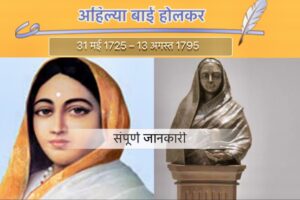
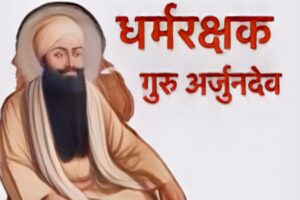
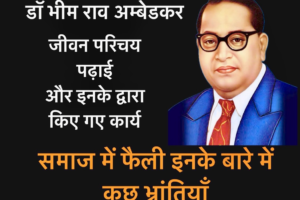

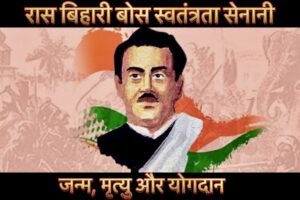
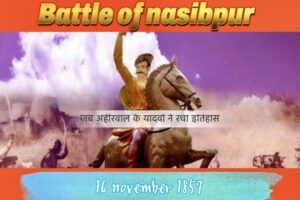

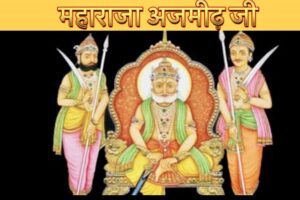
Thank you for your sharing. I am worried that I lack creative ideas. It is your article that makes me full of hope. Thank you. But, I have a question, can you help me?